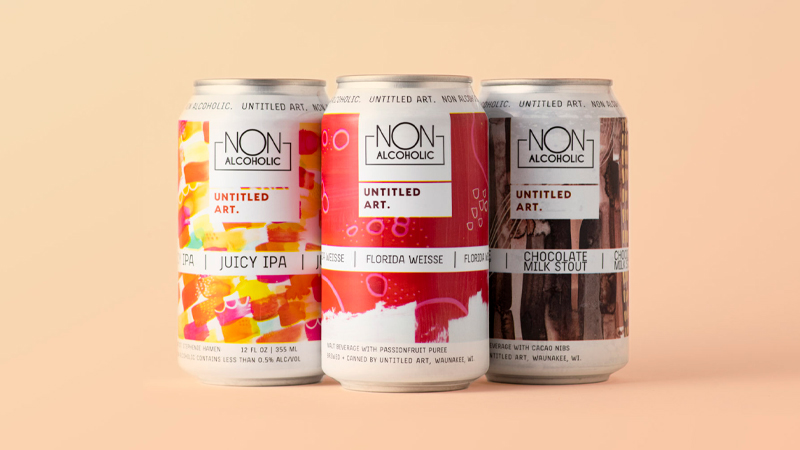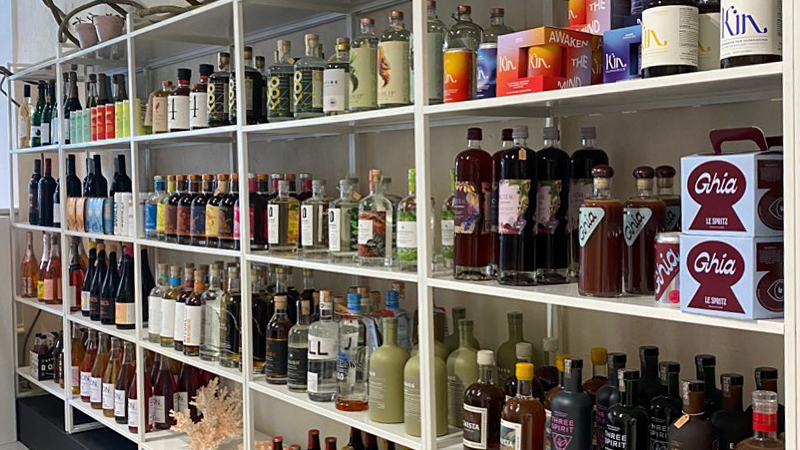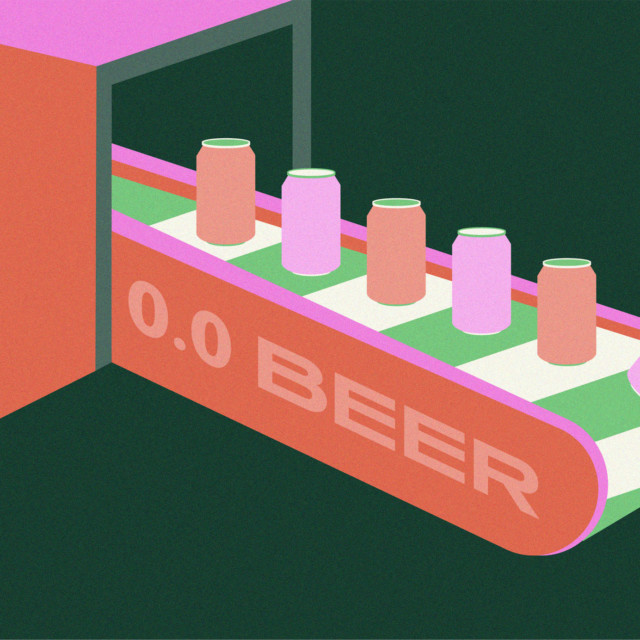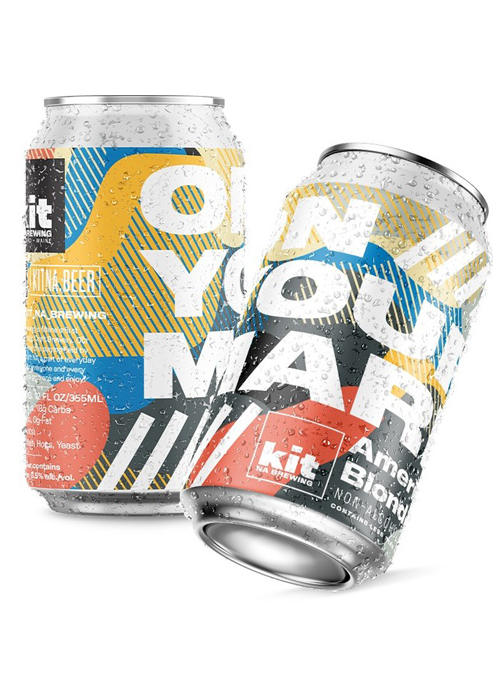Isaac Showaki was right about the trend, just not the timing. Around three years ago, the president and CEO of Octopi Brewing, a contract facility in Wisconsin, decided to bet big on non-alcoholic beer. “We invested in really, really expensive machinery to make sure we could make really good non-alcoholic beer,” says Showaki, also a founder of Untitled Art, which produces trendy stouts and IPAs, CBD-infused sparkling water, and other beverages at Octopi.
The pricey equipment features membrane filtration that lets the brewery create NA beer and a squeaky-clean alcohol base for its fruited Florida Seltzers. “Of course, seltzer took off like crazy,” Showaki says. At the start of 2021, alcohol-free beer was a blip in production, but as September blurred into November, sales of Untitled Art’s NA beer entered an elevator headed one way: up.
“For December and January, we expect non-alcoholic beer to be about 30 percent of our sales,” Showaki says. The creative NA beers, including a Juicy IPA, Italian Pilsner, and S’mores Dark Brew, are so true to flavor they’re tricking a tough crowd. “We’ve given [S’mores] to brewers and it takes them, like, 30 to 40 minutes to figure out that it’s NA beer,” Showaki says.
There was no fooling even five years ago when the category mostly focused on what was missing — alcohol — and not distinct taste. Here’s an O’Doul’s! It kinda tastes like that lager you loved. Oh, you want an IPA or something else? You’re out of luck. The brewing industry leaves no niche unexplored for long.
The last several years have welcomed scores of NA beers that are tapping into trends for tempering alcohol intake, going sober in October and drying off in January. Combined dollar sales of low-alcohol and NA beer increased nearly 29 percent to $287 million in the 52-week period ending Nov. 6, according to NielsenIQ. It’s loose change compared to overall beer sales, totaling $38.5 billion in the same period, but those numbers dipped 3.6 percent during that time frame. (NielsenIQ classifies low-alcohol beer as less than 4 percent ABV; NA beer is 0.5 percent ABV at most.)
The category is getting crowded, and making tasty NA beer is simply table stakes. With the volume of NA beer predicted to increase nearly 11 percent in 2022, according to Global Market Insights, breweries are holding nothing back to separate themselves from a crowded pack.

Turn the Volume Back Up
NA beer is growing, but it’s nowhere near heights reached in 1992. That year, American NA beer production totaled more than 2.4 million barrels, according to Modern Brewery Age; in 2020, domestic breweries didn’t crack the million-barrel mark.
During that era, large breweries flooded the NA field. Miller introduced the NA Sharp’s brand in 1989. O’Doul’s launched in 1990. Coors Cutter came out in 1991. “Having more than one, with no side effects, is now easier than ever,” goes a 1992 article in The New York Times. Amid sodas and Shirley Temples, a cold O’Doul’s must’ve felt like a fizzy godsend. By contrast, drinkers today can select seltzer, kombucha, zero-proof cocktails, alcohol-free wine, CBD tonics, and more. Being alcohol-free can’t be the only selling point.
“Non-alcoholic beer has always existed; it’s just never tasted very good,” says Rob Fink, the founder and CEO of Big Drop Brewing, a U.K.-based NA brewery that contract-brews in Canada, Australia, and Chicago for the American market. The company launched in 2016 with Galactic milk stout, luscious with cocoa nibs and lactose, and has expanded to include a Citra IPA, sour ale, and brown ale. “I get asked all the time, ‘Are you going to do a CBD beer?’” Fink says. “No, no, no. What we’re succeeding in delivering is flavor.”
Since launching in Stratford, Conn., in 2018, Athletic Brewing has become an NA frontrunner known for fragrant IPAs, Mexican-style lagers, peanut butter porters, and coffee stouts targeted to an active crowd. Go on, celebrate that marathon finish with a Run Wild IPA! In the 52-week period ending Oct. 31, dollar sales of its brand family grew 490 percent in grocery, convenience, liquor, and other multi-outlet chain stores, according to IRI, a Chicago-based market research firm.
More growth is imminent. The company scaled its San Diego facility, once home to Ballast Point, to produce nearly 200,000 barrels annually. A recent $50 million funding round that included chef David Chang and football player JJ Watt will fuel a Medford, Conn., brewery that can produce 150,000 barrels annually when it comes online this year. “Capacity has always been our biggest limiting factor, and we saw the opportunity to get out in front,” says Bill Shufelt, co-founder and CEO.
Athletic’s biggest domestic play for 2022 is Athletic Light, a 25-calorie, low-carb pilsner launching nationally in March. The beer is geared toward drinkers who dig the macro lagers still ruling American beer, perhaps elbowing aside older NA brands. “There’s still a lot of dead wood on the non-alcoholic shelf,” Shufelt says.
And there’s room for overlooked styles. “What is needed out there is a very delicious dark beer,” says Veronica Vega, the director of product development for Deschutes Brewery in Bend, Ore.
Deschutes is known for dark beers, in particular Obsidian Stout and the flagship Black Butte Porter. Creating an NA analogue to a beloved beer is tricky, so Vega started with an Irish stout as a flavorful proof of concept. Vega and Deschutes partnered with Colorado’s Sustainable Beverage Technologies to dial in the recipe and processes for its NA Irish Style Dark — dry, roasty, and not cloying. Its successful 2020 launch led Vega and Deschutes to spend some two years fine-tuning Black Butte Dark, which will be widely released in 2022. “Owning dark beer is something that we can do,” Vega says.
A Trying Challenge
Encouraging customers to try a new NA beer can be as difficult as brewing one. In less viral times, beer reps could dole out samples at liquor stores, but “that’s not a thing at the moment,” says Fink of Big Drop. Stateside, Big Drop ran a successful project supplying beer for block parties. In the U.K, the brewery works with grocery and meal-kit delivery companies to add Big Drop to orders and “get beer into the hands of people who might not otherwise know who you are,” Fink says.
Brooklyn Brewery is a household name across America and Europe, which accounts for about half of the company’s overall business, says vice president of sales Miles Moser. NA beers are more entrenched in Europe, so Brooklyn Brewery’s European distributor, Carlsberg Group, asked Brooklyn Brewery to develop one. That led to Special Effects Hoppy Amber, released overseas in 2018.
“We were able to see how more mature non-alcoholic beer markets wanted something more full-flavored,” Moser says. Brooklyn Brewery released Hoppy Amber domestically in fall of 2019 and followed that with a citrusy NA IPA. This fall, Brooklyn Brewery unveiled a 12-pack of four Special Effects beers, including a new pilsner and hazy IPA. It’s the first nationally distributed NA variety pack, a low-risk format for trying new beers. “Many of our distributors view it as a competitive advantage,” Moser says.
Speciality shops helped grow craft beer, offering friendly faces to explain spontaneous fermentation and hazy IPAs. Increasingly, stores such as Boisson in New York City and Soft Spirits in Los Angeles are offering curated NA offerings. In conjunction with e-commerce, specialty stores “are especially important for non-alcoholic beer, wine, and spirits, giving a distribution opportunity to brands that might not have the ability to make their way into a more mainstream store to start,” writes Kaleigh Theriault, the beverage alcohol client manager for NielsenIQ.
Tasting rooms are also terrific for encouraging trial. In January, Kit NA Brewing in Portland, Maine, will launch its first beer, the “American blonde” On Your Mark, and is also looking to launch a tasting room later that year. “It will be an R&D facility for us, so people will be able to try beers that are not on store shelves,” says Rob Barrett, co-founder and president.
The NA-focused Go Brewing in Naperville, Ill., is also building out a taproom that is set to open in April. The space will focus on experiential events, including live music and fitness classes. The hope is to “create a social experience and have fun but not be so reliant on alcohol,” says Joe Chura, a founder.

A Local Outlook
NA beers don’t exist in a geographic vacuum. Because breweries can legally ship beer across state lines, directly to customers, most NA brands are available to anyone at any time. Focusing on your backyard is a smart approach for new NA brands such as Atlanta’s Rightside Brewing, which partners with Big Kettle Brewing to produce its IPA and citrus-y wheat beer. “We’re really trying to build a Southeastern presence,” says founder Emree Woods. “I still think there’s a huge desire for consumers to support local.”
It’s beneficial for small breweries to make NA beer, broadening their customer base, but the necessary machinery can be prohibitively expensive. “You’re looking at about $250,000,” says Patrick Frimat, the vice president of business development for ABV Technology of St. Paul, Minn..
The company’s equipment uses a patented dual-stage vacuum separation process that turns standard beer NA, creating a colorless boozy byproduct that can become a hard seltzer base. Because the equipment is too pricey for most breweries, plus pretty immobile, ABV Technology offers a service for brewers to send in beer for processing. “Instead of bringing the machine to the beer, we bring the beer to the machine,” Frimat says.
ABV Technology works with about 40 breweries around brewery-rich Minnesota. It’s now seeking out brewery-dense clusters across America, placing host machines at Bootstrap Brewing in Longmont, Colo., and Eastern Market Brewing in Detroit, among others. For smaller breweries, “it’s a way to become more inclusive,” Frimat says.
Forever in America, beer and alcohol consumption has existed on a light switch. On. Off. You’re either drinking or you’re not, no dimmer to illuminate all the gray areas in between. We’re steadily moving beyond the binaries, seeing the bright side of lunch, dinner, happy hour, or brunch with a tasty beer lacking nothing but a buzz.
“The real reason I’m confident that NA beer is growing is because I see it day to day in my friend group, my community, and our customers,” says Vega of Deschutes. “If you asked me five years ago if I would be ordering an NA beer at lunch, the answer would have been no. My own practices are changing.”
This story is a part of VP Pro, our free platform and newsletter for drinks industry professionals, covering wine, beer, liquor, and beyond. Sign up for VP Pro now!

